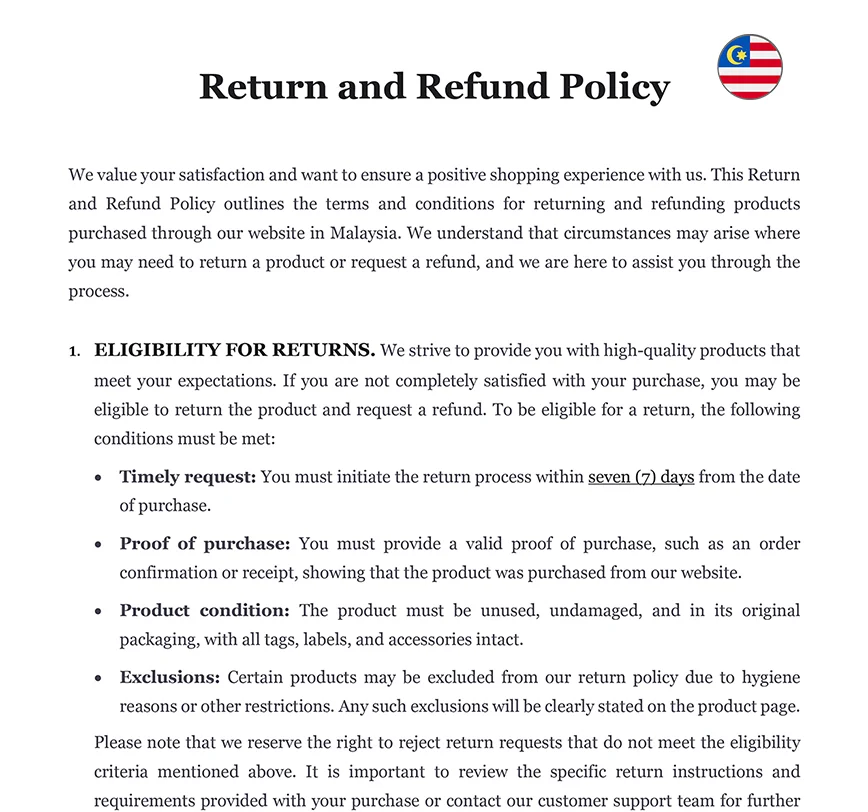Ready to use legal template
Drafted by experienced lawyers
Compliant with Malaysian law
Ready to use legal template
Drafted by lawyers
Compliant with Malaysian law
Home › Intellectual property › Return and Refund Policy
Learn more about Return and Refund Policy in Malaysia
A return and refund policy is a set of guidelines and procedures established by a business or organization to outline the process by which customers can return or exchange products and receive refunds for their purchases. It serves as a clear framework that defines the terms and conditions under which returns and refunds are accepted, including eligibility criteria, timelines, required documentation, and any applicable fees or restrictions. It aims to provide transparency and ensure a fair and consistent approach to customer satisfaction while balancing the interests of both the customer and the business. Themis Partner offers you an easy to edit Return and Refund policy drafted by lawyers to comply with the law in Malaysia.
Table of contents
-
What is a Return and Refund Policy?
-
Why use a Return and Refund Policy?
-
What should it include?
-
What is the process for initiating a return or refund?
-
Are there restrictions on returning certain items?
-
How does it address damaged or defective products?
-
What if I don’t have a Return and Refund Policy?
What is a Return and Refund Policy?
A Return and Refund Policy is a set of guidelines and rules established by a business or organization to outline the terms and conditions regarding product returns, exchanges, and refunds. It serves as a legally binding agreement between the company and its customers, providing clarity and transparency about the rights and obligations of both parties in the event of a return or refund request. The document typically includes information about the time frame for returns, acceptable reasons for returns, the condition of the product for eligibility, any associated fees or restocking charges, the process for initiating a return or refund, and any additional terms and conditions specific to the company’s policies. It aims to protect the interests of both the business and its customers by establishing clear procedures and expectations for resolving issues related to product returns and refunds.
Why use a Return and Refund Policy?
Using a Return and Refund Policy is essential for businesses to establish trust and provide a clear framework for addressing customer concerns.
| ➤ Firstly, it helps manage customer expectations by outlining the conditions under which returns and refunds are accepted. By clearly communicating these terms, customers can make informed decisions about their purchases, reducing misunderstandings and potential conflicts. |
| ➤ Secondly, a well-defined policy helps streamline the return process, making it easier for customers to initiate returns or seek refunds. This enhances customer satisfaction and loyalty by demonstrating that the business values its customers' needs and is committed to resolving any issues. |
| ➤ Additionally, it protects the business from fraudulent claims or abuse by setting boundaries and procedures for returns. It also establishes a consistent approach to handling returns, ensuring fair treatment for all customers. |
Overall, implementing it is crucial for promoting customer satisfaction, maintaining a positive brand image, and mitigating potential disputes or conflicts.
What should it include?
1. Eligibility and Time Frame
Clearly specify the eligibility criteria for returns and refunds, such as whether the product must be unused, unopened, or in its original packaging. State the time frame within which returns or refund requests must be made.
2. Refund Options
Outline the available refund options, such as a full refund, store credit, or exchange for another product. If there are any limitations or conditions for each option, clearly state them.
3. Return Process
Provide detailed instructions on how customers can initiate a return, including any required documentation, such as proof of purchase or product images. Specify the preferred method of return, whether it’s through mail, in-person, or online.
4. Shipping and Handling
Clarify who is responsible for the shipping and handling costs associated with returns or exchanges. Specify if the customer or the business will bear the expenses and any limitations or exceptions that apply.
5. Restocking Fees
If applicable, state whether there are any restocking fees for returned products and provide clear information about the amount or percentage that may be deducted from the refund.
6. Exclusions and Limitations
Identify any specific products or categories that are non-returnable or non-refundable due to hygiene reasons, perishable nature, or custom-made items. Make sure to explain the reasons behind these exclusions.
7. Warranty Information
If the product comes with a warranty, clearly state the terms and conditions of the warranty coverage and how it may affect the return or refund process.
8. Customer Support
Provide contact information for customer support, such as a phone number or email address, to assist customers with their return or refund inquiries.
9. Legal Considerations
Include any necessary legal disclaimers or disclosures to ensure compliance with local laws and regulations governing returns and refunds.
ℹ️ Remember, it is important to make the document easily accessible to customers. It should be prominently displayed on the business’s website, included in product packaging, or made available upon request. Regularly review and update the policy as needed to reflect any changes in business practices or legal requirements.
What is the process for initiating a return or refund?
| ➤ Firstly, the customer should review it to ensure their situation meets the eligibility criteria. If eligible, they may need to gather relevant information, such as proof of purchase or product images, depending on the company's requirements. |
| ➤ Next, the customer should contact the business's customer support through the provided channels, such as a phone number or email address. They should clearly explain the reason for the return or refund request and provide any requested documentation. |
| ➤ The customer support team will then assess the request and guide the customer through the next steps. This may involve issuing a return merchandise authorization (RMA) number, providing a prepaid shipping label, or instructing the customer on how to return the product. |
| ➤ Once the returned item is received and inspected, the business will determine if it meets the necessary criteria for a refund. |
| ➤ If approved, the refund will be processed according to the specified refund option, such as a refund to the original payment method or store credit. |
Are there restrictions on returning certain items?
Yes, there are often restrictions on returning certain items due to various reasons. These restrictions may be influenced by factors such as product type, hygiene considerations, perishable nature, or customisation. Common examples of items that are typically non-returnable include opened software or digital downloads, intimate apparel, swimwear, perishable food items, personalised or customised products, and items with hygienic concerns like cosmetics or earrings. These restrictions are put in place to protect the safety, integrity, and quality of the products, as well as to comply with legal regulations. It is important for businesses to clearly communicate these restrictions in their Return and Refund Policy to set customer expectations and avoid any potential disputes or misunderstandings.
How does it address damaged or defective products?
When a customer receives a damaged or defective item, they should be encouraged to contact customer support immediately to report the issue. The policy should outline the steps for documenting the damage or defect, which may include providing photographs or descriptions. Depending on the circumstances, the business may offer options such as a replacement, repair, or a full refund for the damaged or defective product. The policy should clearly state whether the customer needs to return the item, and if so, whether the business will bear the return shipping costs. Additionally, it should specify any time limitations for reporting damaged or defective products to ensure prompt resolution. By addressing damaged or defective products in a clear and proactive manner, businesses can demonstrate their commitment to customer satisfaction and provide a seamless process for resolving such issues.
What if I don’t have a Return and Refund Policy?
If a business does not have a Return and Refund Policy, it can lead to confusion and potential disputes between the business and its customers. Without a policy in place, customers may be uncertain about their rights and expectations when it comes to returns or refunds. This lack of clarity can result in dissatisfied customers, negative reviews, and damage to the business’s reputation. Furthermore, without a clear policy, the business may struggle to handle return or refund requests consistently, leading to inconsistent or unfair treatment of customers. It is highly recommended for businesses to establish a Return and Refund Policy to provide transparency, protect the interests of both parties, and ensure a smooth and satisfactory resolution of any return or refund-related issues.
SPECIAL OFFER
eCommerce
5 Document Package
Essential website/app policies for online business in Malaysia
Return and Refund PolicyTemplate (.docx)
Easy and quick to customize
310 client reviews (4.8/5) ⭐⭐⭐⭐⭐
Share information
Why Themis Partner ?
Make documents forhundreds of purposes
Hundreds of documents
Instant access to our entire library of documents for Malaysia.
24/7 legal support
Free legal advice from our network of qualified lawyers.
Easily customized
Editable Word documents, unlimited revisions and copies.
Legal and Reliable
Documents written by lawyers that you can use with confidence.




